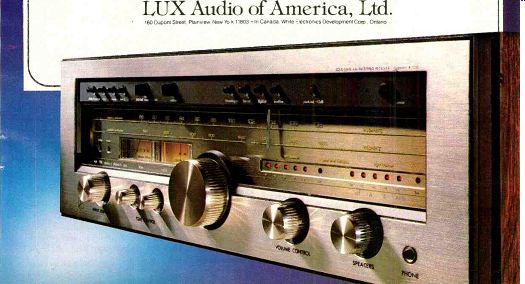As you would expect from LUX, our new R-1050 tuner/amplifier "is no mere run-of-the-mill receiver."

When LUX Audio entered the U.S. audio scene in 1975, we brought with us a worldwide reputation for excellence. But since we also brought only our separate amplifiers and toners, relatively few audiophiles could enjoy the special qualities of LUX performance.
Now, everyone who would like a LUX tuner, preamplifier and power amplifier--on a single chassis--can have them just that way.
We choose to call these new models "tuner/ amplifiers," although you probably think of them as "receivers." What's more important is how Hirsch-Houck Labs described the R-1050 in Stereo Review: "Given its features, appearance and performance, this is no mere run-of-the-mill receiver....The excellent audio-distortion ratings ... obviously place it among the cleanest of the currently available receivers...every aspect of the receiver's operation and handling was as smooth and bug-free as its fine appearance would suggest. "Typical of the circuitry and features that result in such fine performance are these: dual-gate MOSFET front end for high sensitivity, and a special linear-phase filter array for high selectivity, low distortion and wide stereo separation. The preamplifier section has a two-stage direct-coupled amp for accurate RIAA equalization and a good phono overload capability. And the power amplifier is direct-coupled DC, in a true complementary symmetry configuration, for excellent transient and phase response.
Operating features include a six-LED peak level indicator for each channel; tape-to-tape dubbing with simultaneous listening to other program sources; turn-on time delay speaker protection plus automatic overload shutdown.
The sound of the R-1050 has been appreciated as much in England as here. For example, the British magazine HiFi at Home said: "...treble quality was light and delicate, something LUX engineers always seem to achieve... bass output seemed plentiful and strong, as is often the ease with enormous, low impedance power supplies."
If we've encouraged you to experience the sound of a LUX tuner/amplifier, your next step is to visit one of our carefully selected dealers.
We'll be pleased to send you the names of those in your area.
Luxman R-1050: 55 watts per channel, THD 0.05%. Suggested price. $595. Other Luxman tuner/amplifiers: R-1040. 40 watts per channel, THD 0.05%. Suggested price, $445. R-1123, 120 watts per channel. THD 0.03%. Suggested price, $895. (Power ratings are minimum continuous output per channel, with both channels driven simultaneously into 8 ohm loads, from 20 to 20,000 Hz, and no more than quoted total harmonic distortion.)
LUX Audio of America, Ltd. 160 Dupont Street. Plainview. New York, 11803.
In Canada: White Electronics Development Corp. Ontario
Also see:
Source: Stereo Review (USA magazine)